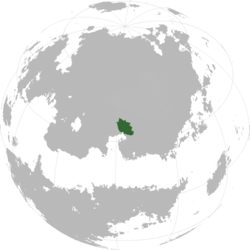Baghazan
| Baghazan |
||||||
|---|---|---|---|---|---|---|
|
||||||
| Capital | Mörtıhn | |||||
| Largest city | Vaqht | |||||
| Official languages | Ashkay | |||||
| Recognised national languages | Amaian Cathan Ghalar Irathi Qeldar Wazan others |
|||||
| Demonym | Ashkay, Baghazani | |||||
| Government | Unitary representative elective semi-constitutional monarchy | |||||
| - | King | Anqhtäsng Nyrülbartu | ||||
| Legislature | Assembly of Baghazan | |||||
| - | Upper house | Council of Clans | ||||
| - | Lower house | Council of Representatives | ||||
| Unification TBD | ||||||
| Area | ||||||
| - | Total | 465,432 km2 179,704 sq mi |
||||
| Population | ||||||
| - | 2020 estimate | 27,786,294 | ||||
| - | Density | 59.7/km2 154.6/sq mi |
||||
| Drives on the | right | |||||
| Internet TLD | .bg | |||||
Baghazan (Ashkay: Bağxzn Baxhzn [bäʁzn̩]) is a country variably categorised as being in eastern Vaniua or western Parshita. It is bordered to the west by Amaia and to the southeast by Jeehoop. With about 28 million inhabitants, Baghazan is the Xth most populous country in Vaniua. Comprising an area of 465,432.07 km2, it is the Xth largest country in Vaniua and the Xth largest on Sahar. Baghazan is a member of the Eastern Vaniuan Association.
Etymology
Baghazan derives its name from the province of the Great Horde of the same name, which held much of the territory of the modern state as well as other lands to the north. This in turn is a Koman name meaning "land of the east".
History
Great Horde
The territory now comprising Baghazan was conquered by [tbd] in [tbd] and was incorporated into the province of Baghazan.
Tamazic Baghazan
Cathan Empire
Vogian Baghazan
The majority of Baghazan, save for an ethnic Cathan-majority strip along the north bank of the Naqui River, was wrested from Cathan control by Vogia in [year]. As one of the most prosperous and prestigious regions of the former Great Horde, ownership of Baghazan was used by the Vogian crown to promote its legitimacy as the successor state to the Asharid realm. ...
Independence and unification
Democratic reforms
Balak involvement
White War
As a client state of the Balak Empire, Baghazan provided key economic, political, and military assistance during the White War. This continued throughout the entirety of the conflict, though Balak-Ashkay relations were tested when Balakia subsequently approached Vogia for military support in the war. The three countries came to an agreement, wherein in exchange for Baghazan being prevented from seeking any further territorial concessions from Vogia, Vogia would enter the conflict on the side of Balakia to serve as a counterbalance against the recent Vos intervention on the Koman side.
Second Treaty of Kavam
During the negotiation process leading up to the Second Treaty of Kavam, which would formally resolve the White War and other simultaneous conflicts, the Ashkay government considered the non-aggression pact with Vogia void, and ordered a full-scale military invasion of the Vogian borderlands. This severely impacted relations with the Vaniuan great powers - including Balakia - who ordered Baghazan to cease the offensive. The Ashkay government ignored these requests and continued its advances. At its greatest extent, the Ashkay-occupied territory extended all the way to the banks of the [tbd] River. With the surrender of the Vogian government, the remaining Vaniuan great powers imposed economic sanctions on Baghazan, with Balakia blockading the country and obstructing its access to the Zwazwam Gulf. After [time tbd], Baghazan relented and rejoined negotiations. In the final draft of the Second Treaty of Kavam, the Ashkay-occupied territory would be divided into two halves, with the northwestern half returned to Vogia and the southeastern half annexed into Baghazan, defining the modern border between the two countries.
Great Ekuosian War
Post-GEW
Geography
Geology
Climate
Biodiversity
Politics
Government
Baghazan is a unitary state and constitutional monarchy, with the King wielding significant executive power as both head of state and head of government. The country is fundamentally structured as a multi-party representative democracy, with legislative power vested in the bicameral Assembly of Baghazan. The Assembly is divided into a lower and upper house - the Council of Representatives and Council of Clans respectively - with the former comprising a number of elected individuals and the latter comprising a delegation of the leading figures in each officially recognised clan in the country. Though the Council of Representatives functions under the Terminian parliamentary system and Terminian federalism, individual provinces have only limited autonomy and self-governance given the political organisation of Baghazan as a unitary state. Clans in Baghazan are non-geographic political entities, with every citizen belonging to one clan and thereby holding the ability to engage in clan politics.
Administrative divisions
Foreign relations
Military
Economy
Transport
Energy
Science and technology
Tourism
Demographics
Ethnic groups
The majority ethnic group in Baghazan are the Ashkay people, a Baitaar people group, who comprise [tbd]% of the population. Other notable groups include Amaians in the west of the country, as well as various Rartakan and Tamazic peoples. Enclaves of Kalkalic peoples are additionally present, such as the Ghalars in the northwest of the country, and Komans in major urban areas.
Urbanisation
Language
The most widely spoken language in Baghazan is Ashkay, which serves as the sole official language on the national level. Given the country's vast linguistic diversity, individual provinces reserve the right to provide services in one or more local languages.
Education
Healthcare
Religion
Culture
Heritage
Architecture
Literature
Art
Music
Theatre
Film
Cuisine
Sport
Symbols
See also
 |

| |||
| ||||
| Zwazwam Gulf |


